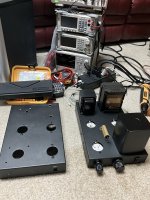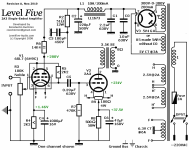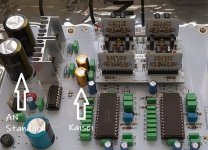I use the K40 & K42 as well but the same value is about 10 times larger than a Vishay, if you are bypassing underneath a PC board sometimes you don't have room for those monsters. They are indeed very organic & I put them on both pair of Monitor Audio speakers I own. I used some of the Teflon Russian's but don't like them as much.
What about high value AN Kaisei as power supply caps in a 150W/ch MOSFET amp? I'm considering the 10K polars. Also in the running are the Mundorf 10K Ecaps. Less concerned about price than about what's appropriate for the task.
Would appreciate your thoughts.
Would appreciate your thoughts.
I have dual bridge soft recovery Quaismodo snubbed EI core with ESL shield transformers with 600,000 uf Nichicon then 2 mh chokes then 8 Blackgate 10,000 uf / 63 V FK and 4 of Blackgate 2,200uf /100V N in dual mono SS 100 watt MosFet Class A power amp driving Martin Logan CLX electrostatics with upgraded crossovers. It’s very, very good and yes too, too expensive……. Or buy your wife a very nice purse
I have Multicap bypasses on the Nichicons, Blackgate bypasses are 16 pairs back to back 0.47 NX in E cancelling arrangement as BG say not to use film bypasses.
Since when 10,000 uf is available from BGI have dual bridge soft recovery Quaismodo snubbed EI core with ESL shield transformers with 600,000 uf Nichicon then 2 mh chokes then 8 Blackgate 10,000 uf / 63 V FK and 4 of Blackgate 2,200uf /100V N in dual mono SS 100 watt MosFet Class A power amp driving Martin Logan CLX electrostatics with upgraded crossovers. It’s very, very good and yes too, too expensive……. Or buy your wife a very nice purse
K series
https://www.hificollective.co.uk/sites/default/files/blackgate_k_data.pdf
Ive never A-B'd Blackgate but if I had some I'd still love to try a Arizona Blue 1uf 200V and a MICA Ruby 0.016uf across them, it does magic all the way with Mundorf AG and Jensen eletrolytics PS caps. Balls, drive, dynamics and resolution and 'in the room real' go up markedly with these added
https://www.hificollective.co.uk/sites/default/files/blackgate_k_data.pdf
Ive never A-B'd Blackgate but if I had some I'd still love to try a Arizona Blue 1uf 200V and a MICA Ruby 0.016uf across them, it does magic all the way with Mundorf AG and Jensen eletrolytics PS caps. Balls, drive, dynamics and resolution and 'in the room real' go up markedly with these added
You've probably seen this, not sure how independent it is https://sw1xad.co.uk/technology_post/black-gate-vkwkz-vs-an-kaisei-review/
My idea of a bulk power supply bypass is adding 1,000-2,200uf caps. I would imagine the Audionote parts would be pretty good for that.
I leave the smaller film caps on the amp circuit board, much closer to the action.
I leave the smaller film caps on the amp circuit board, much closer to the action.
Sumotan
After the chokes each dual mono power supply polarity is all Blackgate 2 x 10,000uf FK and 1 x 2,200uf N in parallel with pairs of 0.47 UF NX bypass
10,000 uf FK in 63 and 80 V
https://www.hificollective.co.uk/sites/default/files/blackgate_k_data.pdf
2200 /100v
https://www.hificollective.co.uk/sites/default/files/blackgate_n_data.pdf
https://sw1xad.co.uk/wp-content/uploads/2016/06/bgtest.pdf
After the chokes each dual mono power supply polarity is all Blackgate 2 x 10,000uf FK and 1 x 2,200uf N in parallel with pairs of 0.47 UF NX bypass
10,000 uf FK in 63 and 80 V
https://www.hificollective.co.uk/sites/default/files/blackgate_k_data.pdf
2200 /100v
https://www.hificollective.co.uk/sites/default/files/blackgate_n_data.pdf
https://sw1xad.co.uk/wp-content/uploads/2016/06/bgtest.pdf
Last edited:
Not rich. Just trying to make sure it all gets used before I check out. Want it to be a sad day for EVERYBODY!😝
Seriously, though, I am just trying to figure out if it's really worth it to spend so much on PS caps. Is there a significant improvement on the less expensive spread?
Thanks for the Nichicon tip. I'm checking out the stats. There's so much stuff you're bound to miss something.
Seriously, though, I am just trying to figure out if it's really worth it to spend so much on PS caps. Is there a significant improvement on the less expensive spread?
Thanks for the Nichicon tip. I'm checking out the stats. There's so much stuff you're bound to miss something.
My vote is the nichicon kg superthrough. A step up from type 2 and type 1. They cost more and they sound better. Use them in crc supply for hughes 39watt se. Very happy.😀
Many people spend many thousands on changing equipment, so £50 or £100 on a cap is 'small change' BUT I soon realised there are lots of caps, lots of cable, heat shrink, solder, tips, foil, adhesive and I soon realised it's not only the expensive items that add up 😳
Still worth it but my immaterial 'dabbling' always seems to be £250+ every month, Farnell, RS, HiFi Collective, Digikey, Screwfix, etc, etc
The pain is the running in before final judgement, if its a valve amp, the cost of a bunch of expensive GEC's burning is a real thought !
Still worth it but my immaterial 'dabbling' always seems to be £250+ every month, Farnell, RS, HiFi Collective, Digikey, Screwfix, etc, etc
The pain is the running in before final judgement, if its a valve amp, the cost of a bunch of expensive GEC's burning is a real thought !
Am seriously considering Kaisei 100 uF 500V NON-polar for position C3 in Konstantin Kuchinin’s 2A3 design in a set of monoblocks I’m building.
As I’m using another AN cap in the 220/500v position I suspect the two may complement each other. the compact size is a plus too as I used 8x12x2” chassis.

I am advised NOT to use a POLAR electrolytic in the C3 position although I’m not exactly sure why. Considering running the PS with one anyway just for testing purposes.
How critical a choice is this?
Thanks in advance.

As I’m using another AN cap in the 220/500v position I suspect the two may complement each other. the compact size is a plus too as I used 8x12x2” chassis.

I am advised NOT to use a POLAR electrolytic in the C3 position although I’m not exactly sure why. Considering running the PS with one anyway just for testing purposes.
How critical a choice is this?
Thanks in advance.

The only reference I have for this is the HiFi Collective website:Am seriously considering Kaisei 100 uF 500V NON-polar for position C3 in Konstantin Kuchinin’s 2A3 design in a set of monoblocks I’m building.
As I’m using another AN cap in the 220/500v position I suspect the two may complement each other. the compact size is a plus too as I used 8x12x2” chassis.
View attachment 1327724
I am advised NOT to use a POLAR electrolytic in the C3 position although I’m not exactly sure why. Considering running the PS with one anyway just for testing purposes.
How critical a choice is this?
''…the all-new Audio Note Kaisei Electrolytic capacitor range specially suited for valve power supply use.
Alternatively the NON-POLAR (bi-polar) offer improved sonic performance…''
This is all they say. Hopefully, someone around here can give us a technical explanation.
Last edited:
Thanks. Went ahead and bought the Kaiseis.
I know me. I’d always wonder what the pricier option sounded like and for this project - likely my last - it’s probably a good place to start given what I’m hearing from the diy-selfers.
I know me. I’d always wonder what the pricier option sounded like and for this project - likely my last - it’s probably a good place to start given what I’m hearing from the diy-selfers.
Much appreciated!I used some standard AN and a pair of Kaisei in the power filtering for the output stage of my DAC, the Kaisei are very detailed with nice mids and good dynamics, subjectively.
View attachment 1329079
- Home
- Design & Build
- Parts
- Audio Note Kaisei capacitors
